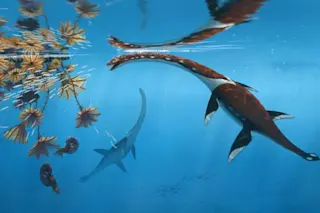Dinosaurs roamed Earth for millions of years, during a major geologic era known as the Mesozoic. Fossils, scientific discoveries and tireless research efforts have gradually unveiled the mesmerizing tapestry of the dinosaur timeline.
Their captivating tale begins in the Triassic period, reaches its peak during the well-known Jurassic period and comes to a dramatic end in the late Cretaceous period. Discover how each of these distinct periods served as a stage for the evolutionary dramas that unfolded, as new species emerged and others faded away.
How Long Ago Did Dinosaurs Live?
The dawn of dinosaurs began with the Permian mass extinction, also known as the Great Dying. This event, around 252 million years ago, killed more than 90 percent of life on Earth at the time.
Scientists are unclear on what actually caused this mass die-off (warming temperatures and volcanic activity likely played a role) but it is widely recognized as the worst extinction ever to have occurred.
Read More: Here’s What Dinosaurs Really Looked Like
The Triassic Period
After this catastrophe, ecosystems changed and mammal-like reptiles came to dominate on land. This era is known as the Triassic Period. They were also accompanied by archosaurs, a group that included early dinosaurs. Exactly when dinosaurs emerged during this period, however, is up for debate; for some time, paleontologists believed Eoraptor was the first.
A paper published in 2013, on the other hand, argued that the two-legged Nyasasaurus — dating back to around 243 million years ago — is actually the earliest dinosaur, or at least one of its relatives. And another fossil recently found in Africa, belonging to Mbiresaurus raathi, is recorded as the continent’s earliest known dinosaur and an early relative of the towering sauropods.
Read More: How the Triassic Extinction Helped Dinosaurs Take Over the Planet
The Jurassic Period
At the beginning of the Triassic, Earth’s landmass was one supercontinent called Pangea. As the period drew to a close and Pangea began to split in two, however, another mass extinction occurred. Like the previous one, the exact causes are still unknown — though a changing climate is considered a likely cause.
Fortunately, dinosaurs survived.
As the dinos entered the Jurassic period, Pangea’s gradual separation into Laurasia in the North and Gondwana in the South coincided with cooler temperatures and increased rainfall. This spurred the growth of new vegetation, such as ferns and conifer trees.
As the flora changed, dinosaurs diversified. Most striking in the Jurassic is perhaps the rise of the sauropods, such as Brachiosaurus and Diplodocus. They spread far and wide, and grew to enormous sizes, feasting on the abundant plant life.
Theropods, two-legged meat-eaters, also grew larger — Allosaurus and Ceratosaurus are two prominent examples. Meanwhile, iconic armored herbivores like Stegosaurus appeared on the scene, too.
Read More: As Meat-Eating Hunters With Strong Jaws, Theropods Ruled the Mesozoic
The Cretaceous Period
At the end of the Jurassic, some 145 million years ago, a further shift in the continents prompted yet more flourishing dinosaur evolution. What came next is known as the Cretaceous, a period that lasted 79 million years.
During this time, sauropods reached ever greater sizes and heights; one of the largest was Patagotitan (literally “the titan from Patagonia”), stretching to heights of more than 120 feet as it roamed the Early Cretaceous.
We owe some of the most famous and largest meat-eating dinosaurs — such as Tyrannosaurus Rex, Spinosaurus, and velociraptor — to the Cretaceous, too. Dinosaurs filled all kinds of ecological niches, and researchers some believe the giant reptiles reached their peak diversity during the mid-Cretaceous period.
Read More: The End of Dinosaurs: The End-Cretaceous Mass Extinction
Why Did Dinosaurs Go Extinct?
But this success was not meant to last. Around 66 million years ago, an asteroid thought to be roughly 6 miles wide struck the Yucatán Peninsula in Mexico. This collision triggered a mass die-off that reverberated through ecosystems, wiping out all non-bird dinosaurs.
Paleontologists continue to uncover new facets of dinosaur behavior, ecology and appearance through fossils, however. And much remains to be learned about how they came to rule Earth for so long.
It’s entirely possible that a large swathe of dinosaurs remains to be discovered.
Read More: Two Asteroids May Have Wiped Out the Dinosaurs















